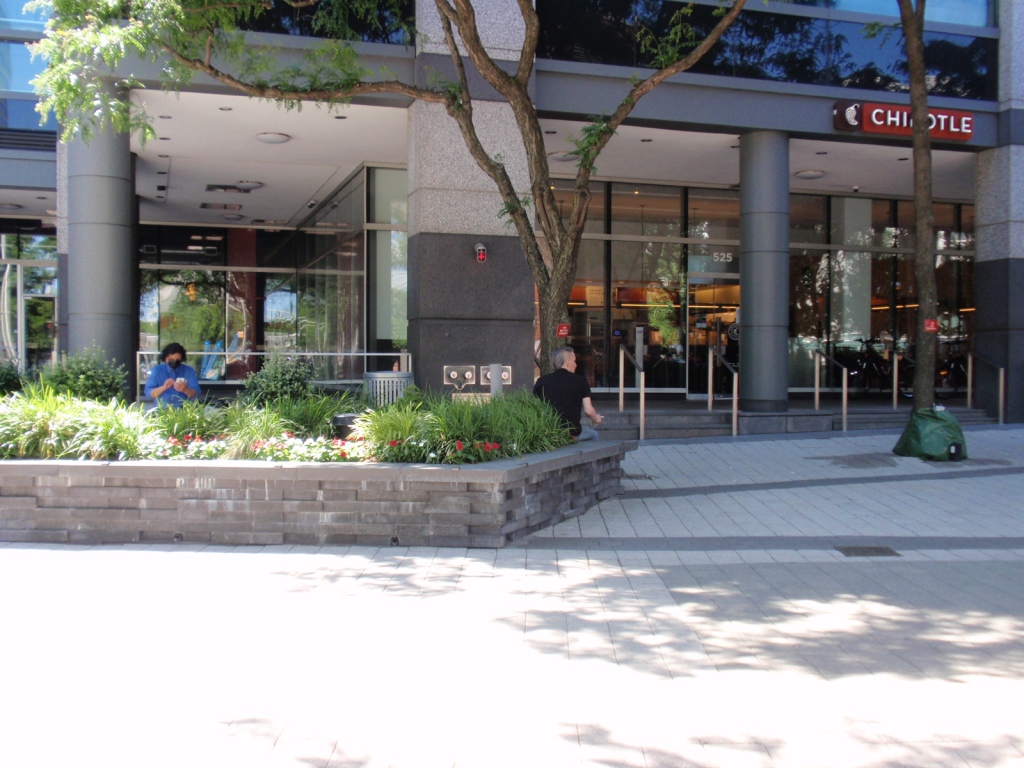William H. White, one of the most famous and influential urban planners of the 20th century, examined how the design of an urban space can attract or deter people from using it. He studied a variety of urban spaces such as parks, plazas, playgrounds and city streets and observed how people responded to these built environments. One of his most well-known studies was of plazas outside of office buildings in midtown Manhattan. Plazas are spaces created by zoning regulations requiring that buildings be set back a certain distance from the curb or property line to let more light and air into a space.

The trees add some shade and visual interest but there is no public seating..
In his research Whyte found some plazas had many people involved in various activities while others were empty. He wanted to know why. His findings are insightful in examining plazas outside office buildings downtown by the waterfront to see how successful they are in attracting people and making them vibrant public spaces. According to Whyte, several factors contribute to making plazas appealing places for people to gather:
A plaza should connect directly to the street and the flow of pedestrian traffic.

Plazas that are not easily visible or accessible to pedestrians will not attract many people.

Plazas should have stores, cafes, restaurants and other enterprises because they attract people and add to the social life of the street.

Seating is one of the most important factors in attracting people to a plaza. Benches, movable chairs, ledges and steps are important examples of seating that draw people to a plaza.

A key factor in determining whether people use a plaza is sittable space – It must be the right height and have enough space to sit on comfortably.

Plazas without seating or other attractions become empty public spaces.

Food plays a large role in attracting people to a plaza. It can be street vendors, restaurants or cafes.

Whyte found that “people are attracted to other people.” People like to be among other people in public.

Whyte found that people like to watch other people. However, that finding is challenged by more recent research that shows electronic devices are now engaging people more, making them less focused on others. Whyte’s research reflects a “bottom-up” approach to urban planning because he takes into account the people’s preferences in designing public spaces. This contrasts with much of urban planning which is top-down with little input from those affected. Whyte focused on small public spaces because he saw them as key aspects of urban life and people’s well-being. In his study of plazas, as well as in his other writings, Whyte had much to say about urban life. He believed that interacting with others in public spaces enhances our quality of life and helps us feel part of a community.

For Whyte a vibrant public life starts with the street. “The street is the river of life of the city. The place where we come together, the pathway to the center.” For Whyte, the best streets consist of short blocks which are pedestrian-friendly and provide some of the best urban spaces – street corners – places where people often linger in conversation. He was critical of long blocks with their blank walls and megastructures with entrances that turn inward, away from the street.

Whyte lamented the loss of sunlight in the city as taller, bulkier buildings cast bigger shadows.

Whyte felt too much space was given to vehicles at the expense of pedestrians. making walking less safe, interesting and appealing.

Finally, Whyte felt that cities were losing their centers or core areas in which much of the city’s activities from business, to shopping as well as entertainment and recreation take place. Whyte’s critique applies to much of the built environment downtown by the waterfront. With its sprawling buildings scattered along highway-like roads, it looks more like a series of suburban office parks than a city.

As the architecture critic, Paul Goldberger, once observed, “In a great or even a good city, the whole is usually more than the sum of its parts. In Jersey City, the parts and the whole are essentially the same thing, an incoherent splatter of buildings.”

The absence of the feel and look of a city downtown is because its design and layout was largely developer-driven, lacking enough oversight from the city to ensure a more vibrant and equitable space. The question now is: how can it be redesigned to address these issues?
Follow This Blog
Get new content delivered directly to your inbox.
- Gentrification Math & the False Promise of Affordable Housing
- Why is the City Selling Public Property to Luxury Housing Developers?
- Why So Much Luxury Housing in a City Where Most Can’t Afford It?
- Why Do So Many New Apartment Houses Look Alike?
- Signs of Gentrification: House Numbers, Their Color and Design
